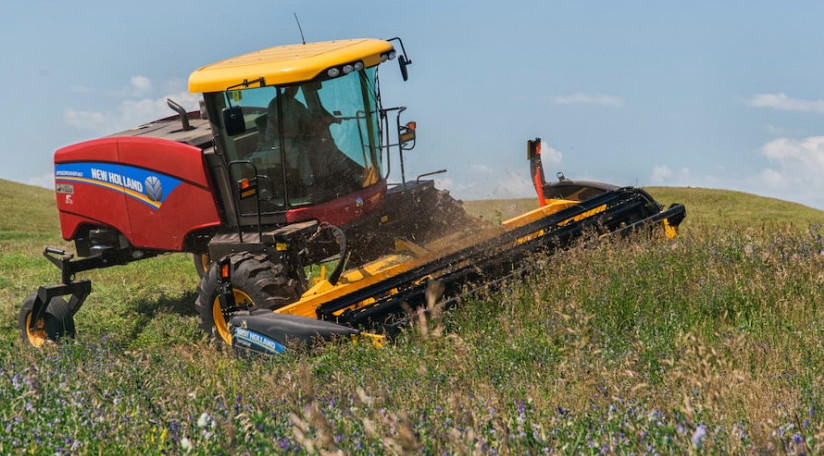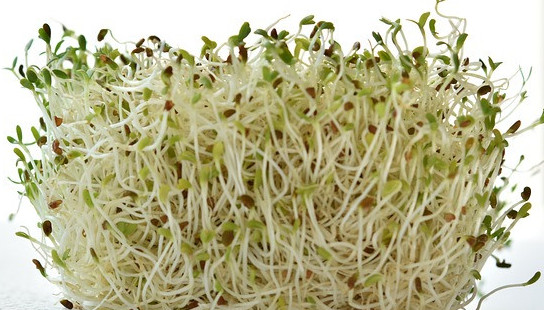
It is very difficult to accurately say when and where alfalfa was first cultivated. It was used as a forage and feed for animals prior to recorded history. It probably originated in Persia (now mainly Iran) and from there found its way to Arabia where it seems to have picked up its name, “alfalfa” which can be translated as “the best forage.” There seem to be two theories of how alfalfa came to North America. In both cases it came as a forage or cattle feed. One theory is that it had been taken as seed to Chile by Spaniards who eventually became responsible for bringing it to California. The other theory is that a more winter-hardy seed came from the British Isles. In either case alfalfa made its way to Utah from where it was distributed across North America. Two names have been recognized for centuries for this perennial forage. Seeds coming by way of Spain and Chile have long been called “alfalfa” while the second variety from the British Isles is known as “lucerne.” On my many trips to Great Britain I have found that British farmers still use the term lucerne for this hay crop. Alfalfa has long, narrow leaves and purple, yellowish or white flowers.
ALFALFA AS FEED FOR ANIMALS
For centuries alfalfa was known primarily as an animal feed. Eventually this led to the more refined usage for cows and then primarily for beef cows. My first exposure to alfalfa was as a feed for the beef cows I grew as a teenager. My Father taught me quickly that alfalfa as a certain portion of their feed was the most economical and the most efficient way to grow an animal up to a 1,000 pound weight. Alfalfa is one of several legumes (clovers, vetches, peas and beans) and is a nitrogen-fixer meaning that it draws nitrogen out of the air and converts it into protein. Alfalfa can produce more than 1,800 pounds of protein per acre per year which makes it very valuable as an animal feed. Good quality alfalfa hay can produce as much digestible nutrients per ton as twenty-five bushels of corn.
ALFALFA AS HUMAN FOOD
One of the mysteries seems to be when alfalfa was first used as a human food. It is known and recorded that both Thomas Jefferson and George Washington grew alfalfa in small acreages but there does not seem to be any record of them having used it as a nourishing food. Alfalfa has been recognized for centuries as a very nutritious horse and cattle feed. But if you chew the mature plant it is very fibrous and not very desirable. At some point it was discovered that young sprouts can be a flavorful addition to salads and sandwiches. It is through eating sprouts and supplements that alfalfa is consumed by humans.
Alfalfa is a low calorie and very nutrient dense food. It has a very rich soluble fiber content which makes it a favorable addition to many diets. Many consider alfalfa to be a true superfood. Alfalfa sprouts are a fine source for vitamins A, B, C, E, and K. Leafy, green alfalfa is very high in carotene, a precursor for vitamin A. Sprouts are not nearly as high in this nutrient. Alfalfa is a good source of the minerals manganese, phosphorus, calcium, zinc and magnesium. Alfalfa also is known to be the source of many phytonutrients. As with all plants, the nutrient content of alfalfa will vary depending upon the soil quality on which it is grown.
It is interesting that, even though alfalfa has considerable research as a cattle feed, there is little true scientific research on it as a human food or supplement. On the other hand, there are thousands of anecdotal recordings of its use in traditional and herbal medicines to treat a variety of health conditions. Alfalfa sprouts have a pleasant slightly nutty flavor and are crunchy when fresh.
SOME ADDITIONAL THOUGHTS ON ALFALFA
Alfalfa is processed today in many ways for human consumption. It is a source of many supplements and is a wonderful natural source of chlorophyll. Want to grow your own alfalfa sprouts? Here is an easy way to do so. If you have a jar with a mesh lid this will be ideal. Put two tablespoons of alfalfa seed in the jar. Add one-half cup of water and let soak overnight. Drain the jar through the mesh lid and rinse thoroughly. It is best to do this twice. The next day rinse again and then rinse two or three more times. Keep the jar out of direct sunlight. After about three days tiny sprouts will begin to appear. Move the jar to where it will receive some indirect sunlight so the sprouts will begin to turn green. When the sprouts are about three inches tall they are ready to harvest and eat. They should be used within a few days. Care should be taken, not to allow harmful bacteria to develop, especially in sprouts purchased in a grocery store.
I may earn a commission for items purchased through this website.
Please leave me any comments or questions.

Although I knew that alfalfa is a cattle feed, I knew nothing about its history or origin. The fact that there are two strains of the same thing with different names, from different countries is interesting. We have used alfalfa sprouts for years as garnish on salads. I did not know that it had any actual food valuable. It’s inexpensive, filling and attractive on salads. We will probably look into using it on more dishes. Thanks for highlighting alfalfa
Jim
Thanks for your comments. Yes, alfalfa sprouts do have real food value!
Hey. You are so genius because you have chosen a great piece of information to talk about. I agree with all you said. Alfalfa is commonly used as a nutritious livestock feed, but it is also consumed by humans in the form of sprouts or as an ingredient in salads and sandwiches. Additionally, alfalfa leaves can be dried and brewed into tea, which is believed to have health-promoting properties.
Yes, alfalfa tea is used by many! Thanks for the comments.